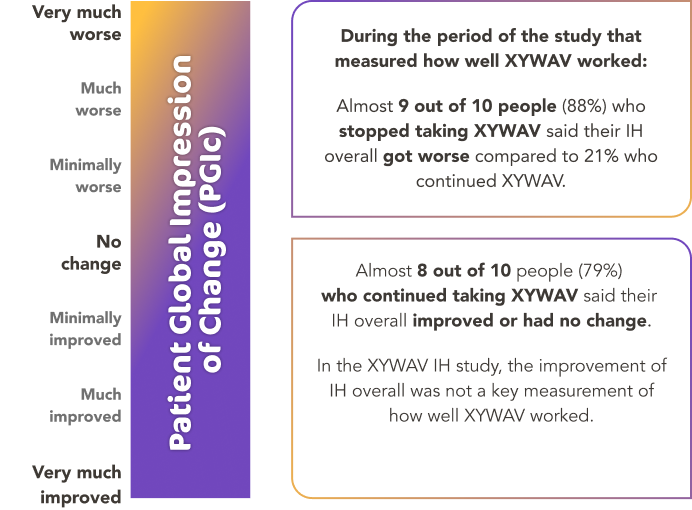
Study Results with XYWAV
Study results for XYWAV in adults with Idiopathic Hypersomnia (IH)
XYWAV has been studied across several symptoms of IH that may affect you, including excessive daytime sleepiness (EDS), long sleep time, cognitive impairment, and sleep inertia.
- The efficacy and safety of XYWAV were studied in 154 people aged 19 to 75 with IH.
- All people in the clinical study started treatment with XYWAV. Some participants continued taking their stimulant or wake-promoting agent along with XYWAV.
- XYWAV was adjusted to a stable dose (the dose that worked best for each person). Then they were randomly assigned to:
- Continue treatment with XYWAV.
- OR
- Stop taking XYWAV for 2 weeks. These people were switched to a placebo, a treatment that is inactive. This was to see if there was a difference in their symptoms.

It’s important to know…
This trial was double-blinded. That means neither the investigators who ran the trial nor the people in the trial knew who got XYWAV or who got placebo during the period of the trial that measured how well XYWAV worked.
*Not everyone completed the 10- to 14-week portion of the study.
A clinical study of nightly XYWAV showed that, compared with placebo
(a treatment that is inactive), XYWAV:
Helped treat excessive daytime sleepiness (EDS)
Helped with overall IH symptoms (patient reported)
Helped with the severity and frequency of IH symptoms like long sleep time, cognitive impairment, and sleep inertia
What changes in EDS were seen in people during the XYWAV clinical study?
- EDS is measured by a screener called the Epworth Sleepiness Scale (ESS).
- The ESS measures EDS on a scale from
0 to 24.

Note: The information collected during the first part of the study was not meant to measure how well XYWAV worked.
Stable dose = the dose of XYWAV that worked best for each person.

Results shown here used average scores, which were then rounded up or down. That's why the difference between scores may not always appear to add up.
Not sure of your ESS score?
Find out your level of daytime sleepiness and be sure to share your results with your doctor.
Source: Johns MW. A new method for measuring daytime sleepiness: the Epworth Sleepiness Scale. Sleep.1991;14(6):540-545.
The Epworth Sleepiness Scale (ESS) is intended to measure EDS, a symptom of IH. It is not intended to make an IH diagnosis.
What changes in overall IH symptoms were seen in people during the XYWAV clinical study?
- The Patient Global Impression of Change (PGIc) screener was used to measure how well XYWAV helps treat symptoms of IH overall.
- The PGIc asked participants to rate how their IH felt using a 7-point scale ranging from “very much improved” to “very much worse.”

Worsening was defined as “minimally, much worse, or very much worse” IH overall. Improvement was defined as “minimally, much improved, or very much improved” IH overall.
What changes in IH symptoms were seen in people during the XYWAV clinical study?
- Severity and frequency of IH symptoms is measured by a screener called the Idiopathic Hypersomnia Severity Scale (IHSS).
- The IHSS is a unique screener—it is the only one validated to measure multiple IH symptoms.
- The IHSS asks participants to answer 14 questions related to the frequency and intensity of a range of symptoms—including excessive sleepiness, long sleep time, cognitive impairment, and sleep inertia.
- The IHSS measures frequency and severity of IH symptoms on a scale of 0 to 50.

Note: The information collected during the first part of the study was not meant to measure how well XYWAV worked.
Stable dose = the dose of XYWAV that worked best for each person.

Results shown here used average scores, which were then rounded up or down. That's why the difference between scores may not always appear to add up.
Do you know your IHSS score?
Rate the severity and frequency of your IH symptoms and be sure to share your results with your doctor.
Source: Dauvilliers Y, Evangelista E, Barateau L, et al. Measurement of symptoms in idiopathic hypersomnia: the Idiopathic Hypersomnia Severity Scale. Neurology. 2019;92(15):e1754-e1762.
The Idiopathic Hypersomnia Severity Scale (IHSS) is intended to measure the frequency and severity of IH symptoms. It is not intended to make an IH diagnosis.
Find out more about XYWAV
Find out about the possible side effects of XYWAV
Ask your doctor if XYWAV is right for you
Get information and stay supported
From learning more about your IH, to helping start the conversation with your doctor, and exploring XYWAV as a treatment option—take charge of your journey with support every step of the way.
